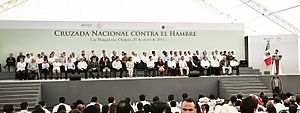National Crusade Against Hunger (Mexico) facts for kids
The National Crusade Against Hunger (also known as CNCH) was a big program started by the Mexican government. Its main goal was to help reduce hunger and poverty in Mexico. It aimed to improve how communities lived by building better things like roads and schools. The program was announced by Mexican president Enrique Peña Nieto on December 1, 2012. It officially began on January 21, 2013, in Las Margaritas, Chiapas.
Contents
What the Crusade Wanted to Do
The National Crusade Against Hunger had five main goals. These goals focused on fighting hunger, improving food, and getting people involved.
- End Hunger: The program wanted to stop hunger in very poor communities. It also aimed to get rid of serious malnutrition in children.
- Better Food Production: It worked to reduce food waste after harvests. This included food lost during storage, transport, and selling. The program also wanted to help farmers grow more food and earn more money.
- Community Power: A key goal was to encourage people in communities to work together. This teamwork helped achieve all the other goals.
The Secretariat of Social Development (SEDESOL) was in charge of this program. They aimed to help 7.4 million Mexicans who faced hunger in 400 different towns. Many groups worked together, including federal, state, and local programs. Even an online group called sinhambre.org helped. The Crusade also included fun activities like photography, short films, and music contests. April was even called the "Month of the Crusade."
Working Together: The Intersectoral Commission
A special group called the Intersectoral Commission helped guide the Crusade. This group made sure all the different parts of the program worked well together. It included leaders from 16 government departments and three national social groups. Rosario Robles Berlanga, who was the minister of SEDESOL, led this important commission.
Who Helped the Crusade?
Many different groups, companies, and schools joined the Crusade. These included universities, non-governmental organizations (NGOs), and large food companies.
- Universities: Four major universities in Mexico helped out. These were the Metropolitan Autonomous University (UAM), the National Autonomous University of Mexico (UNAM), the Monterrey Institute of Technology and Higher Education (ITESM), and the National Polytechnic Institute (IPN). Students from these universities could do their social service in the communities. UAM led a special project in Guerrero. UNAM focused on studying social issues related to hunger.
- NGOs: Groups like "A Kilo of Help" (Un kilo de Ayuda or UKA) focused on helping children. The Mexican Red Cross also played a big part. They offered health education for kids and taught about good nutrition. They helped set up community gardens and taught about healthy eating habits. The Red Cross also helped deliver food and supplies. They even helped after disasters and created a "Route against hunger" in many towns.
- Companies: Big companies like Nestlé and PepsiCo also joined. Nestlé offered many hours of nutrition training in communities. They also helped 15,000 homeowners start small businesses. Nestlé also supported farmers who provided milk and coffee. PepsiCo helped develop new food products and supported projects in poor communities. They also donated products and helped during disasters.
What the Crusade Achieved
In April 2013, many important agreements were signed. These included deals with the universities, NGOs, and large companies. An agreement was also signed with the governor of Hidalgo state. This helped connect existing programs with the Crusade's goals.
On April 19, 2013, Luiz Inácio Lula da Silva officially launched the first groups of the Crusade in Zinacantán, Chiapas. These groups went into communities to find out what people needed most.
Some special programs were also started:
- "Observer Children": This program gave cameras to children. They used the cameras to record changes happening in their communities.
- Nutritional Orientation Networks "The Crusades": This program aimed to teach 500,000 women about healthy eating. They learned how important good nutrition is for children's growth and development.
The Crusade began its work on January 21, 2013, in two places in Guerrero state. These were the town of Mártir de Cuilapán and the Simón Bolivar neighborhood in Acapulco.
In Mártir de Cuilapán, projects focused on getting clean water, planting trees, and creating temporary jobs. The community was very involved in these efforts. In Simón Bolivar, a special day for oral health was organized. Odontology students from the Autonomous University of Guerrero helped with this. A temporary job program also created 150 jobs. People worked with the Mexican Army to clean a river in their neighborhood.
See also
 In Spanish: Cruzada nacional contra el hambre para niños
In Spanish: Cruzada nacional contra el hambre para niños


